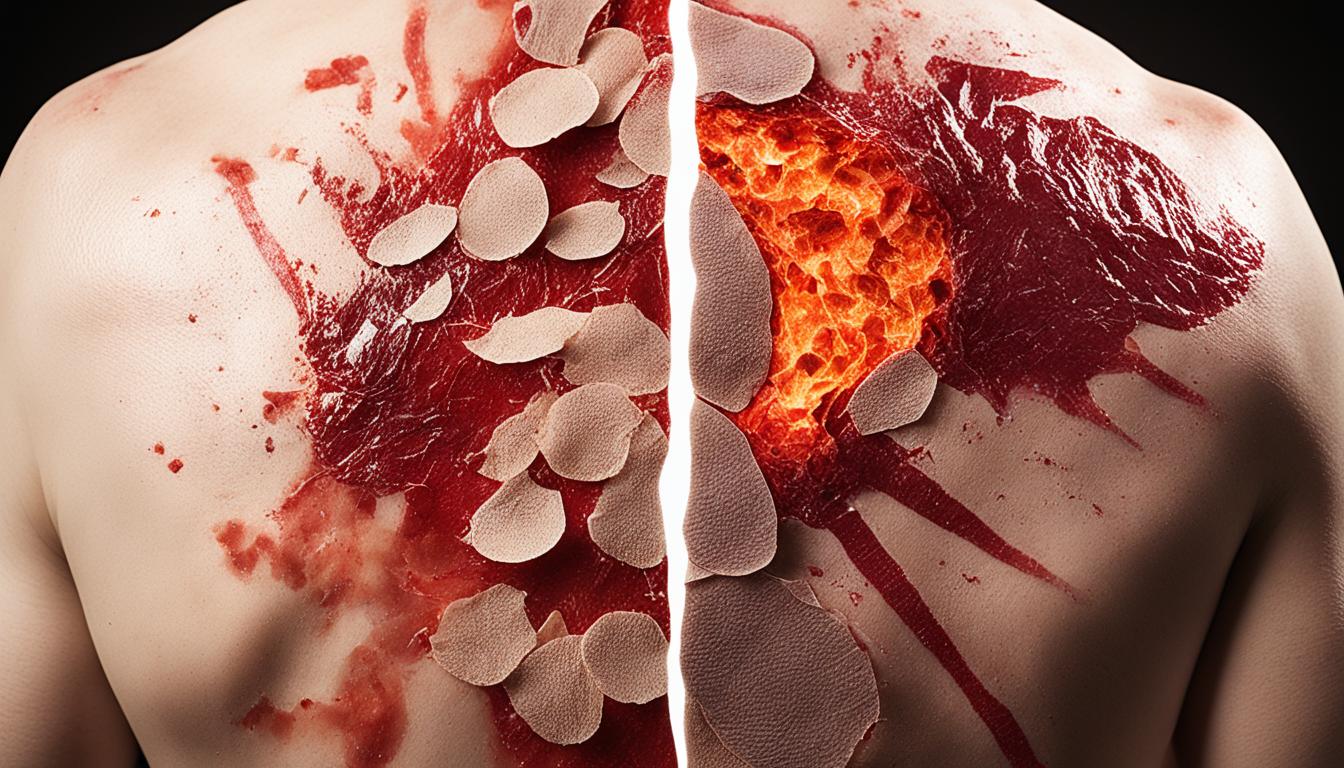Burn injuries are a big concern around the world, leading to sickness and death. They can happen from heat, electricity, or chemicals, affecting people of all types. These injuries vary in severity and can harm the skin and organs. Quick recognition and proper care are key for recovery.
Symptoms of burns include pain, redness, blisters, and swelling. Severe burns might make it hard to breathe, damage skin, and tissues badly.
Doing the right first aid, like running cold water on the burn or covering it, cuts down on damage and pain. Still, it’s vital to see a doctor for better care and assessment.
To diagnose burns, doctors look at the injury and ask about medical history. Tests like blood tests or checks on how bad the burn is help decide on treatment.
Stem cell therapy is a new, exciting way to treat severe burns. Stem cells can turn into different cells and encourage new tissue growth. They have already helped speed up healing in tests.
Various stem cells, like mesenchymal and adipose-derived, are being looked at. They might be able to help burns get better.
They make new blood vessels and cut down on swelling, which help the burn heal faster.
We’re still learning about using stem cells for burns, but it could be a breakthrough. More research and trials will show if it can really benefit patients.
Key Takeaways:
- Burn injuries are a significant public health concern that can result from various causes.
- Immediate first aid measures and medical attention are crucial for minimizing tissue damage and pain.
- Symptoms of burn injuries may include pain, redness, blistering, and swelling.
- Stem cell therapy shows promise in accelerating burn wound healing through angiogenesis and anti-inflammatory actions.
- Further research is needed to fully explore the potential of stem cell therapy for burn injuries.
Mechanisms of Stem Cell Therapy for Burn Wound Healing
Stem cell therapy helps heal burn wounds by several means. A big way is through angiogenesis, the development of new blood vessels. They help grow blood vessels, improving blood flow and bringing more oxygen to the wound.
Moreover, stem cells reduce swelling in the wound by adjusting the immune system. This mix of creating new vessels and calming inflammation helps burn wounds heal faster.
How Stem Cells Promote Angiogenesis for Burn Wound Healing:
- By producing growth factors, stem cells help endothelial cells form new blood vessels.
- These factors also boost the work of VEGF, a key factor in blood vessel growth.
- Some stem cells turn into pericytes, which support the new blood vessels.
Anti-Inflammatory Effects of Stem Cells in Burn Wound Healing:
- They stop inflammatory immune cells and lower the production of harmful cytokines.
- Stem cells encourage the growth of anti-inflammatory cells like T cells, controlling swelling.
- They also send out compounds that cut down on swelling directly, aiding the healing process.
Stem cells do two important things at once: they grow blood flow and ease inflammation. This helps heal burn wounds by making the area more favorable for skin regeneration.
Types of Stem Cells Used in Burn Wound Healing
Stem cells have become key in advancing burn wound healing. Mesenchymal stem cells (MSCs), adipose-derived stem cells (ADSCs), and hair follicle stem cells are leading this effort. They bring special regenerative powers to the table, aiding the recovery and growth of skin tissue. This trio shows great promise in healing burn wounds.
Mesenchymal Stem Cells (MSCs)
Mesenchymal stem cells, or MSCs, are known for their diverse potential. They can become many cell types, including those for skin. This makes them vital for healing burn wounds. MSCs not only aid tissue renewal but also lessen scarring. Their use in burn wound treatment has led to better results for patients.
Adipose-Derived Stem Cells (ADSCs)
ADSCs come from fatty tissue and function much like MSCs. They can become various cell types and have shown to help in wound healing. They are easy to obtain and have drawn much research interest for treating burn injuries.
Hair Follicle Stem Cells
Hair follicle stem cells are found in our hair follicles and are indeed special. They can turn into various cells necessary for rebuilding tissue, including skin. These cells help close wounds, improve tissue quality, and regenerate the skin. Their characteristics make them indispensable in the healing process of burns.
Stem cell therapy introduces a wide range of burn wound healing solutions. Together, MSCs, ADSCs, and hair follicle stem cells are pivotal in this field. Ongoing research aims to boost the power of these cells for speeding up burn injury healing.
| Stem Cell Type | Potential in Burn Wound Healing |
|---|---|
| Mesenchymal Stem Cells (MSCs) | Promote tissue regeneration, reduce scar formation, enhance healing process |
| Adipose-Derived Stem Cells (ADSCs) | Promote wound healing, readily available source for therapy |
| Hair Follicle Stem Cells | Improve wound closure, enhance tissue integrity, contribute to skin regeneration |
Conclusion
Stem cell therapy is showing a lot of promise for treating burn wounds. It works by helping in the healing of burns. Stem cell therapy can increase the growth of new blood vessels, and it reduces inflammation.
Research with various stem cell types, like mesenchymal and adipose-derived cells, has been positive. Yet, we need more studies and tests to understand stem cell therapy better. Finding the best ways to use stem cells, including how much to use and how to give them, are still big questions.
As we learn more about stem cells from research and clinical trials, the future looks hopeful. Using stem cells to enhance the healing of burns is a new direction. The ultimate aim is to develop effective stem cell treatments that notably help people with burn wounds.

